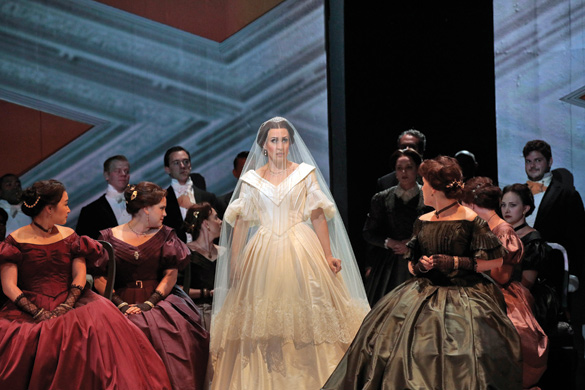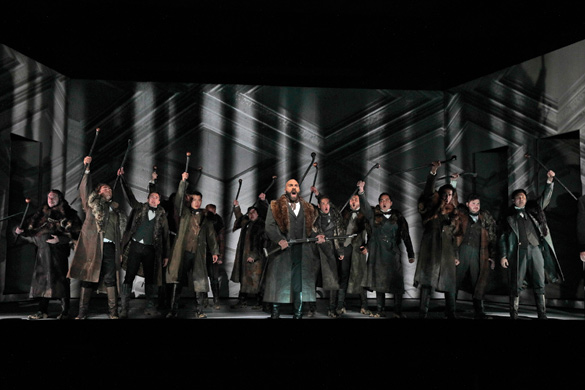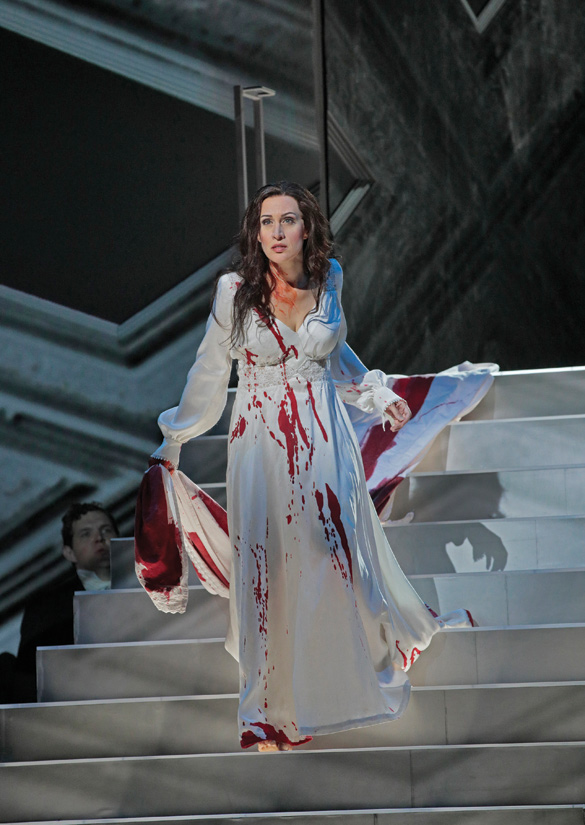 Lucia (Brenda Rae) and the Santa Fe Opera Chorus. Photo by Ken Howard for Santa Fe Opera, 2017
Lucia (Brenda Rae) and the Santa Fe Opera Chorus. Photo by Ken Howard for Santa Fe Opera, 2017 Enrico Ashton (Zachary Nelson) and the Santa Fe Opera Chorus. Photo by Ken Howard for Santa Fe Opera, 2017
Enrico Ashton (Zachary Nelson) and the Santa Fe Opera Chorus. Photo by Ken Howard for Santa Fe Opera, 2017By CARL NEWTON
Los Alamos
The opening weekend of the Santa Fe Opera followed the ridiculous Die Fledermaus on Saturday night with the sublime bel canto seria Lucia di Lammermoor by Donizetti directed by Ron Daniels. Daniels had never seen Lucia before the task of directing it was presented to him. He proved more than worthy of the challenge.
Daniels’ modus operandi is to study the score, ask probing and very smart questions, and bring together very talented designers to collaboratively create a fresh, elegant, and ravishingly beautiful production.
When the audience entered on Saturday night they were looking at three patterned walls and a bare stage. The vinyl printed walls resembled coffered ceilings, but instead of squares they were diamond shapes as though a shearing stress had deformed them. Set designer Riccardo Hernandez produced a minimalist, but definitely not a simple dramatic space in which the story of the hapless Lucia unfolds.
Corrado Rovaris, the maestro leading this bel canto opera hales from the birthplace of Donizetti and his masterful rendition swells the drama from start to finish. This is a diva’s opera and we are moved by the dramatic lyricism brought together between the orchestra and the singers.
Act 1 commences with 17 furious men brandishing cudgels. They are members of the Ashton clan that costume designer Emily Rebholz has dressed in black adorned by trophy furs. They are soon joined by Lucia’s brother Enrico, sporting a rifle. Baritone Zachary Nelson displays the kind of swagger and vocal skill that is truly impressive, and unleashes his vitriol against his sworn enemy Edgardo, the last Lord of Ravenwood.
Tenor Mario Chang is vocally resplendent as Edgardo, who saved Lucia’s life and won her heart. Edgardo and Lucia pledge their love together by exchanging rings before he leaves for France to secure an alliance to defeat the Ashtons. The beautiful melody they sing as lovers will be heard in the next to last scene of the opera when she becomes unhinged and appears in the famous Mad Scene and the orchestra reprises the melody.
Enrico’s chicanery towards his sister drives her into madness by forcing her into an arranged marriage to bolster his fortunes. When Lucia appears in a wedding dress we are treated to the beautiful gowns that Rebholz has designed for the ladies, bringing color to the scene for Donizetti’s famous Lucia Sextet, combining the voices of the each of the principals voicing their fears and also joined by the chorus of guests.
The walls of the set are the projection screens for images that are projected throughout the entire opera. Director Daniels has reservations about the use of projections, but he thinks the way they help the story lines of this production has been his best experience with them to date.
The walls have a more fundamental purpose in this production as they are the confining spaces where the psychological drama is intensified. In one scene, Lucia seems to be searching for an escape as she gropes her way along the walls. The walls have a parapet design that allows persons to peer down from above, which produces a very chilling effect when the men’s chorus is above and Edgardo is alone below, as though he is trapped in a canyon.
When Donizetti wrote the score he knew of Ben Franklin’s glass harmonica, and wanted those eerie vibrations to augment Lucia’s madness. Maestro Rovaris has been fortunate to have in the corner of the orchestra pit, on the side where the harp is positioned, the musician Friedrich Heinrich Kern who is a very accomplished artist with a verrophone (French for glass is verre). The verrophone is many times louder than Franklin’s invention, and is able to be heard very clearly throughout the theater. Rovaris has given us a Mad Scene that replaces the more traditional flute in the long instrumental duet with the floundering Lucia.
The program books (there is one for your reference in each Los Alamos library) and the half-hour Prelude Talks in Stieren Hall (the first two hours before each performance, and the second, a repeat, an hour before the curtain) are excellent resources for enhancing the experience of attending the operas.
Another excellent source is the company’s website at SantaFeOpera.org, where I found the 2017 Prelude Talk Schedule. That is where it shows that on opening night for Mason Bates’ (R)evolution of Steve Jobs the production staff will be in the Crosby Theatre in place of a talk in Stieren Hall.
Ron Daniels has said that the production designs are not what we should anchor our night at the opera judgments on. What is truly important is how each of the performers communicates with the audience. Our role from our seats in the theater is to give our rapt attention to the singers.
Okay, no more soap box in this review. But I can tell you that the rousing standing ovation on opening night was heartfelt.
 Lucia (Brenda Rae) and Edgardo (Mario Chang). Photo by Ken Howard for Santa Fe Opera, 2017
Lucia (Brenda Rae) and Edgardo (Mario Chang). Photo by Ken Howard for Santa Fe Opera, 2017 Lucia (Brenda Rae). Photo by Ken Howard for Santa Fe Opera, 2017
Lucia (Brenda Rae). Photo by Ken Howard for Santa Fe Opera, 2017
